Your Call
In today’s post, I share ten of my favorite images made on the last day of the second 2025 Homer IPT. Like our nine previous sessions on the boat, it offered a wide variety of situations, backgrounds, light, weather, and winds (or the lack thereof). The great beauty of the trip was that despite the unseasonably warm and cloudy weather, each and every day was different and rewarding.
Below each sub-title, the green italic line represents what I called out to the group as a matter of instruction (or, with Image #10, what I called out to the captain). I am proud of the fact that in each instance I not only saw the shot and called it out to the group, but that I made the shot I had envisioned. And I am equally proud that in many of the situations Anita, Steve, Bear Bob, and Brian (The Mailman) Bower each created some memorable photographs.
For me yet again, the 300mm f/2.8 GM lens was my primary tool. For the first time on this Homer trip, I used it with the 1.4X TC (and the a- ii) for flight photography. I created more than 1350 images with the hand held 420mm rig and every single image was razor sharp on the bird’s eye or eyes. Thirty-six of my 125 keepers (after the first edit) were created with the 300mm f/2.8 GM lens and the 1.4X TC for an unusually high keeper rate of 2.66%. Those images merit a blog post of their own.
Please leave a comment noting your three favorite images and let us know why you made your choices. I will share my three top picks (in order of my preference) with you here soon. Along with my reasons. My #1 pick is miles ahead of my second favorite.
If you are impressed by the images you see here and by the unparalleled learning that takes place on a Homer IPT and are seriously interested in joining me next year, please LMK ASAP via e-mail or via text to 863-221-2372. Several spots are already spoken for.
The Last Blog Post
In the last blog post, Midair Bald Eagle Flight Miracle? here, my very favorite image was #2, the 3X2 version. Why? For me, the anticipation of the action in the wider frame was more exciting than what I saw as the lukewarm action in #3, the square crop. And I liked the balance and the image design of Image #2 best.
What’s Up?
Anita North, Steve Shore, and I pulled out of the Land’s End parking lot at 5:47 am. Though there was nothing untoward in the forecast, I had been worried a bit about a blizzard causing serious delays. Within an hour it began to snow, light at first and then heavier. Fortunately, however, the snow quit within a few minutes and the road to Anchorage was clean and green. After several stops for restrooms, food, and eventually to fill up the gas tank of our Jeep Wagoneer, we arrived at Ted Stevens International Airport before 11:00am. By 12:30pm we had all checked in for our flights home.
After the longest final descent in the history of aviation, I landed in Seattle. After a fairly short layover, I boarded AK 394 for my red-eye flight to Orlando.
Today is Tuesday 24 February 2025. After another blessedly uneventful flight — after two glasses of red wine, I managed to sleep a whole 90 minutes. I landed at MCO at 5:25am and as Jim woke early to pick me up, we were headed to ILE before 6:00am.
I am sure that I will be a bit jet-lagged for a few days. On Friday, I am having surgery to have a sqaumous cell carcinoma excised from my right forearm just forward of the elbow. Whatever you opt to do, I hope that you too choose to have a great day.
If an item — a Delkin flash card, or a tripod head — for example, that is available from B&H and/or Bedfords, is also available in the BAA Online Store, it would be great, and greatly appreciated, if you would opt to purchase from us. We will match any price. Please remember also to use my B&H affiliate links or to earn 3% cash back at Bedfords by using the BIRDSASART discount code at checkout for your major gear purchases. Doing either often earns you free guides and/or discounts. And always earns my great appreciation.
Supporting My Efforts Here
If you enjoy and learn from the blog, are all set for gear, or live overseas, consider leaving a BAA Blog Thank You Gift here.
If you enjoy and learn from the blog, please consider using one of my affiliate links when purchasing new gear. It will never cost you a single penny. To support my effort here, please order from B&H by beginning your search here. Or, click here, to order from Bedfords and enter the discount code BIRDSASART at checkout to receive 3% cash back to your credit card and enjoy free Second-Day Air Fed-Ex shipping. It is always best to write for advice via e-mail.
In many cases, I can help you save some serious dollars. And/or prevent you from purchasing the wrong gear from the wrong shop.
|
|
|
This image was created on 23 February at Kachemak Bay, AK on the last day of the second 2025 Homer IPT. Standing at full height on the boat, I used the hand held Sony FE 300mm f/2.8 GM OSS Lens (Sony E) and The Latest Greatest Sony Flagship Body, the a1 II Mirrorless Camera. The exposure was determined via Zebras with ISO on the thumb dial. ISO 2000: 1/2500 sec. at f/2.8 (wide open) in Manual mode. RawDigger showed that the exposure was dead solid perfect: AWB at 9:15:19am during a brief snow squall on a cloudy morning. Zone/AF-C with Bird Eye/Face Detection enabled performed perfectly. Click on the image to see a larger, sharper high resolution version Image #1: Bald Eagle in flight with snow flurries |
Snow Flurries — Briefly
Pre-focus on the wall first to avoid focusing on the snowflakes
It began snowing as we headed across Kachemak Bay.
Oh goodie,
we said. Radar shows that it should be snowing for two more hours the captain said as we pulled up to The Wall in Poot Bay. We were excited to finally see some snow after ten days without a trace of the white stuff. Ten minutes after we began shooting it stopped snowing. You gotta love it.
|
|
|
This image was also created on 23 February at Kachemak Bay, AK on the last day of the second 2025 Homer IPT. Standing at full height on the boat, I used the hand held Sony FE 300mm f/2.8 GM OSS Lens (Sony E) and The Latest Greatest Sony Flagship Body, the a1 II Mirrorless Camera. The exposure was determined via Zebras with ISO on the thumb dial. ISO 2000: 1/2500 sec. at f/2.8 (wide open) in Manual mode. RawDigger showed that the exposure was dead solid perfect: AWB at 9:22:23am on a then cloudy & foggy morning. Zone/AF-C with Bird Eye/Face Detection enabled performed perfectly. Click on the image to see a larger, sharper high resolution version Image #2: Bald Eagle in flight against white sky with wings raised |
High Key White Sky
There’s some nice stuff high on the port side. Be sure to work 1/3-stop darker than you were on the starboard side
The wind had dropped to zero as the snow stopped. At that point, I noticed some eagles turning high in the air on the opposite side of the boat. I called out instructions and several of the group joined me.
Why work 1/3-stop darker with the birds high against the white sky? There was a lot more light up there than against the rock wall to our starboard side. Zebra technology helped immensely, of course; I wanted some Zebras on the bright sky.
|
|
|
This image was also created on 23 February at Kachemak Bay, AK on the last day of the second 2025 Homer IPT. Standing at full height on the back of the boat, I used the hand held Sony FE 300mm f/2.8 GM OSS Lens (Sony E) and The Latest Greatest Sony Flagship Body, the a1 II Mirrorless Camera. The exposure was determined via Zebras with ISO on the thumb dial. ISO 1600: 1/2500 sec. at f/2.8 (wide open) in Manual mode. RawDigger showed that the exposure was dead solid perfect: AWB at 9:22:23am on a then cloudy & foggy morning. Zone/AF-C with Bird Eye/Face Detection enabled performed perfectly. Click on the image to see a larger, sharper high resolution version Image #3: Bald Eagle in flight over scenic headland |
Bald Eagle Scenic
Check out the long scenic shot of an eagle turning in flight above the distant headland; you’ll need to be patient
I fell in love with the fog-shrouded scene the moment I glanced toward the stern so I alerted the group. Anita North had already seen the possibility, so I made my way through the cabin to join her on the stern. Brian (The Mailman) Bower soon joined us. As the boat swung a bit, the shot was available from either the stern or from the bow. The keys to the success of the image was the crop from the top left and brightening and bringing up the color of the headland’s trees and rocks.
|
|
|
This image was also created on 23 February at Kachemak Bay, AK on the last day of the second 2025 Homer IPT. Standing at full height on the boat, I used the hand held Sony FE 300mm f/2.8 GM OSS Lens (Sony E) and The Latest Greatest Sony Flagship Body, the a1 II Mirrorless Camera. The exposure was determined via Zebras with ISO on the thumb dial. ISO 1250: 1/2000 sec. at f/2.8 (wide open) in Manual mode. RawDigger showed that the exposure was dead solid perfect: AWB at 9:52:32am on a then cloudy & foggy morning. Zone/AF-C with Bird Eye/Face Detection enabled performed perfectly. Click on the image to see a larger, sharper high resolution version Image #4: Bald Eagle starting dive |
Dramatic Fog Bank Flight Pose
Get on the birds as they are dropping down from above the mountains and try to position the bird right in the middle of the fog bank
With a dramatic band of fog across the snow-covered mountain ridges just above the earthquake-drowned trees, the obvious plan was to create an image with the bird centered in the fog bank. So that is what I did. The dramatic diving pose was a lucky bonus. In the original frame the bird was on the left side of the frame. As it was glancing to its right, I moved the bird to the other side of the frame by painting a Quick Mask of the bird with lots of surrounding sky to our left of the eagle. The sky portion of the mask covered part of the bird in its original position. The rest of the bird was removed by circling it with the Patch Tool (my keyboard shortcut “P”) and the hitting Shift + Delete, the default command for Content Aware Fill. Moving the bird in the frame took perhaps a bit more than a minute.
|
|
|
This image was also created on 23 February at Kachemak Bay, AK on the last day of the second 2025 Homer IPT. Standing at full height on the boat, I used the hand held Sony FE 300mm f/2.8 GM OSS Lens (Sony E) and The Latest Greatest Sony Flagship Body, the a1 II Mirrorless Camera. The exposure was determined via Zebras with ISO on the thumb dial. ISO 1250: 1/2000 sec. at f/2.8 (wide open) in Manual mode. RawDigger showed that the exposure was dead solid perfect: AWB at 9:52:32am on a then cloudy & foggy morning. Zone/AF-C with Bird Eye/Face Detection enabled performed perfectly. Click on the image to see a larger, sharper high resolution version Image #5: Bald Eagle in flight just above dead earthquake-drowned tree background |
Staring Right Down-the-Lens-Barrel
There are some birds flying directly at us from the right; try to include the earthquake-drowned forest in the frame
I’ve been in love with the two earthquake-drowned dead tree groves in China Poot Bay for well more than a decade. In March of 2011 I used the old, tripod/Mongoose-mounted Canon 800mm f/5.6 EF L IS lens with the EOS-1D Mark IV to create a vertical pan blur of the trees. I believe that it is featured in A Guide to Pleasing Blurs (co-written and illustrated by Denise Ippolito) but could not find a copy on my laptop 🙂 In this one I love the soft light, the down-the-lens-barrel stare and the varied background layers.
|
|
|
This image was also created on 23 February at Kachemak Bay, AK on the last day of the second 2025 Homer IPT. Standing at full height on the boat, I used the hand held Sony FE 300mm f/2.8 GM OSS Lens (Sony E) and The Latest Greatest Sony Flagship Body, the a1 II Mirrorless Camera. The exposure was determined via Zebras with ISO on the thumb dial. ISO 500: 1/4000 sec. at f/2.8 (wide open) in Manual mode. RawDigger showed that the exposure was dead solid perfect plus a bit: AWB at 9:56:59am as the sun broke through the fog. Zone/AF-C with Bird Eye/Face Detection enabled performed perfectly. Click on the image to see a larger, sharper high resolution version Image #6: Bald Eagle diving through the brightly sunlit swatch of water |
A Huge Challenge
If you are gonna try for the bird in the super-bright swatch, you need to reduce your exposure four to five stops …
Once the sun broke through the fog, the result was a swatch of super-bright highlights on the water. Most of the birds coming to the bait were flying right to left into the wind and by the time they hit the bright patch of water, they were flying away from us. The trick was to get on the odd bird flying left to right and toward us. Patience was the key.
The autofocus system of the a-1 ii was much better at acquiring and maintaining focus than the AF system of the original a-1.
|
|
|
This image was also created on 23 February at Kachemak Bay, AK on the last day of the second 2025 Homer IPT. Standing at full height on the boat, I used the hand held Sony FE 300mm f/2.8 GM OSS Lens (Sony E) and The Latest Greatest Sony Flagship Body, the a1 II Mirrorless Camera. The exposure was determined via Zebras with ISO on the thumb dial. ISO 400: 1/4000 sec. at f/4.5 (stopped down 1 1/3 stops) in Manual mode. RawDigger showed that the exposure was dead solid perfect. AWB at 10:00:44am as the sun was trying to break through the fog (again). Zone/AF-C with Bird Eye/Face Detection enabled performed perfectly. Click on the image to see a larger, sharper high resolution version Image #7: Bald Eagle bright sky silhouette — Golden Eagle |
The Golden Eagle
Look for birds flying above the ridge below the sun and set a much darker exposure, about plus one off the bright sky. Even though the sky there looks white, there is plenty of gold in them there hills!
As we had not lost a morning session to rain or to rough seas and because there was not a single sunny afternoon, we did not — for the first time ever, have a single chance to do a sunset sailing. When the sun was partially obscured by light fog, I alerted the group to the possibility of creating some golden yellow white sky silhouettes. As the sun was just out of the frame lower right, the sky behind the bird was toasted. I moved the bird forward in the frame and then painted a Quick Mask of the sky from in front of the bird, flopped it and covered the too-bright sky, refined the layer with the addition of a Regular Layer Mask, adjusted the tonality of the layer, and then blended the edges.
|
|
|
This image was also created on 23 February at Kachemak Bay, AK on the last day of the second 2025 Homer IPT. Standing at full height on the boat, I used the hand held Sony FE 300mm f/2.8 GM OSS Lens (Sony E) with the Sony FE 1.4x Teleconverter and The Latest Greatest Sony Flagship Body, the a1 II Mirrorless Camera. The exposure was determined via Zebras with ISO on the thumb dial. ISO 400: 1/4000 sec. at f/4.5 (stopped down 1 1/3 stops) in Manual mode. RawDigger showed that the exposure was dead solid perfect. AWB at 10:00:44am as the sun was trying to break through the fog (again). Zone/AF-C with Bird Eye/Face Detection enabled performed perfectly. Click on the image to see a larger, sharper high resolution version Image #8: Glaucous-winged Gull taking flight |
Look Ma, No Head
Hey gang, as the eagles are taking a break, we will have some good chances on the gulls that are cleaning up the scraps. As they are a lot smaller than the eagles, I am adding my 1.4X TC
Many folks believe that unless you can see the face and eye (or the eyes) of a bird, you cannot have a pleasing image. I beg to differ. While I kept about a dozen of the images of the glaucous-wingeds taking flight, the wings fully forward flight pose was my clear favorite of the group.
|
|
|
This image was also created on 23 February at Kachemak Bay, AK on the last day of the second 2025 Homer IPT. Standing at full height on the boat, I used the hand held Sony FE 200-600mm f/5.6-6.3 G OSS lens (at 496mm) and The Latest Greatest Sony Flagship Body, the a1 II Mirrorless Camera. The exposure was determined via Zebras with ISO on the thumb dial. ISO 2000: 1/000 sec. at f/6.3 (wide open) in Manual mode. RawDigger showed that the exposure was dead solid perfect. AWB at 12:05:10pm on a then cloudy afternoon Tracking: Spot XS/AF-C with Bird/Animal Eye/Face Detection enabled performed perfectly. Click on the image to see a larger, sharper high resolution version Image #9: Sea Otter with large pup on its belly |
Too Cute!
Be sure to add at least a stop of light to the metered exposure to ensure detail in the pup’s dark fur
After re-crossing Kachemak Bay following our daily morning eagle sessions, we will usually poke around Homer Harbor in search of a few birds or otters. My favorite lens for the harbor cruising is the Sony 200-600 as it allows me to zoom out at times while providing 600mm of reach when needed. I gladly trade the loss of 1/3 stop of light (as compared to the 300mm f/2.8 lens and the 2X TC) for the versatility of the slightly slower zoom lens.
Bird/Animal Eye/Face Detection
I believe that the Sony a-1 ii is the first Sony camera to offer Bird/Animal Eye/Face Tracking as a subject target choice. After enabling it in the AF Menu, I’d hit the C2 button to access it at the beginning of our harbor cruises. I was quite impressed with its performance as it grabbed and tracked the eyes of the otters much better than Bird Eye/Face tracking and it killed on the birds as well as seen in the following photo. Two for the price of one!
|
|
|
This image was also created on 23 February at Kachemak Bay, AK on the last day of the second 2025 Homer IPT. Standing at full height on the boat, I used the hand held Sony FE 200-600mm f/5.6-6.3 G OSS lens (at 600mm) and The Latest Greatest Sony Flagship Body, the a1 II Mirrorless Camera. The exposure was determined via Zebras with ISO on the thumb dial. ISO 1250: 1/3200 sec. at f/6.3 (wide open) in Manual mode. RawDigger showed that the exposure was dead solid perfect. AWB at 12:16:24pm on a then cloudy afternoon Tracking: Spot XS/AF-C with Bird/Animal Eye/Face Detection enabled performed perfectly. Click on the image to see a larger, sharper high resolution version Image #10: Common Goldeneye drake taking flight |
The Wings Fully Down Flight Pose
Captain, the wind is from the east so stay to the right so that we will have a shot at the take-off as we get closer
On Day 2 of the second IPT, Anita North had a great chance on goldeneyes as we were pulling into the slip. (Anita never puts her gear away until we are docked and tied up.) Having put away my lens, I grabbed the 2-6 from my Think Tank bag, turned the camera back on, raised the shutter speed for a flight shot, and raised the ISO as needed. I was ready for the take-off. I pressed the shutter button when the first of the two hen goldeneyes took off, only to have my camera tell me “No memory card in slot.” As Anita would say, Rotter!
I was glad to have a chance on this single drake. It was the last image made on our last sailing on the last day of my trip.
Note that Tracking: Spot XS was my choice for both the otters and the ducks as either Zone or Tracking: Zone with the a-1 ii has a greater tendency to grab the water when working swimming subjects than Zone or Tracking: Zone did with the original a-1.
Typos
With all blog posts, feel free to e-mail or to leave a comment regarding any typos or errors.

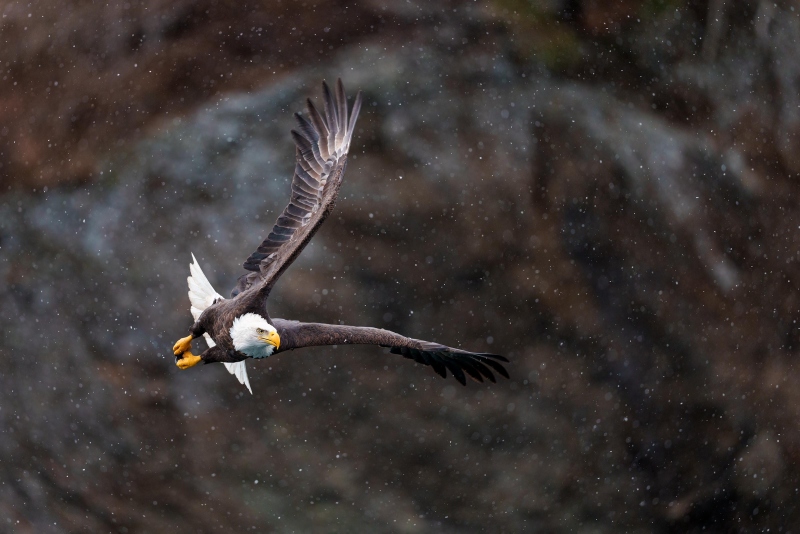
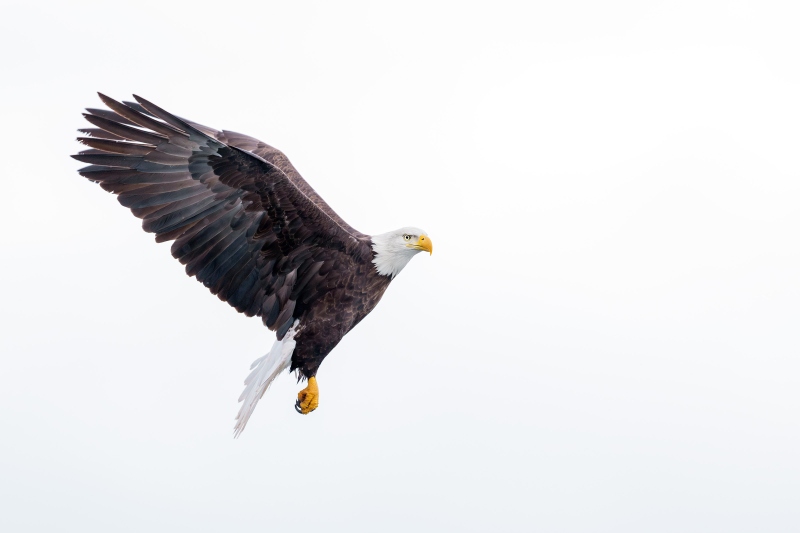
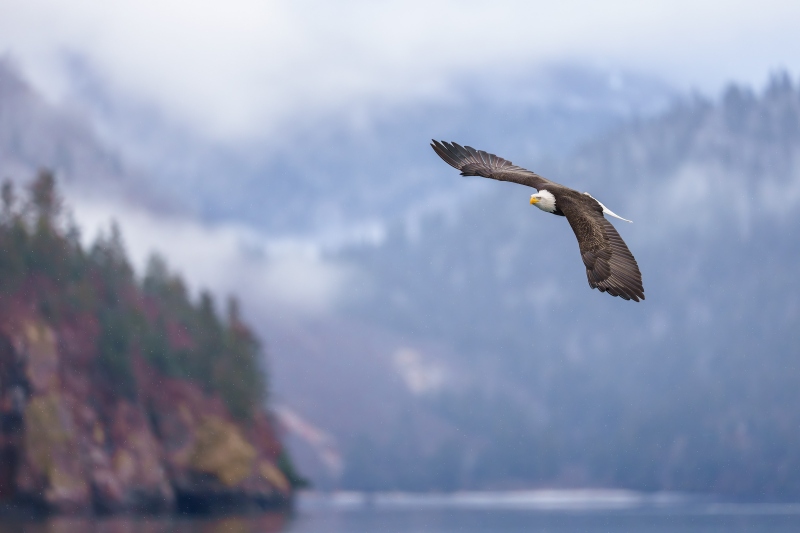
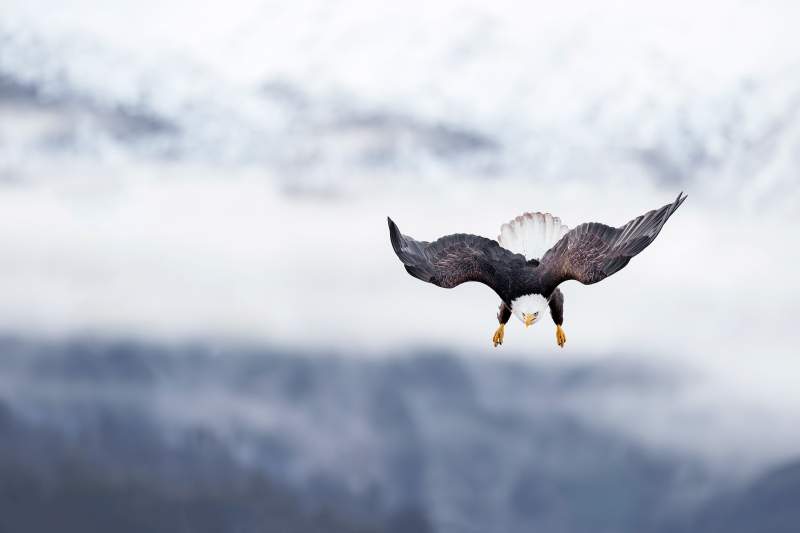
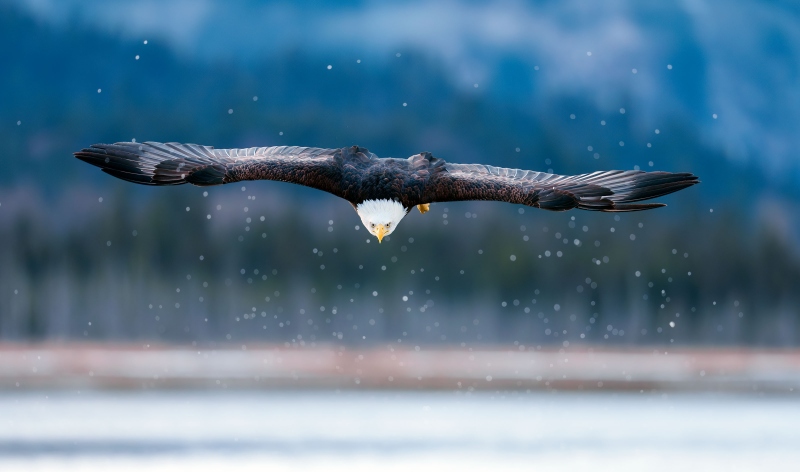
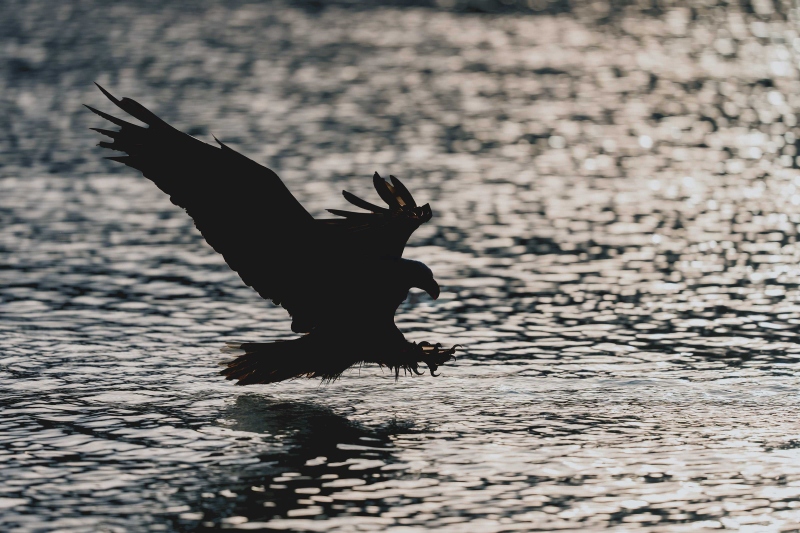
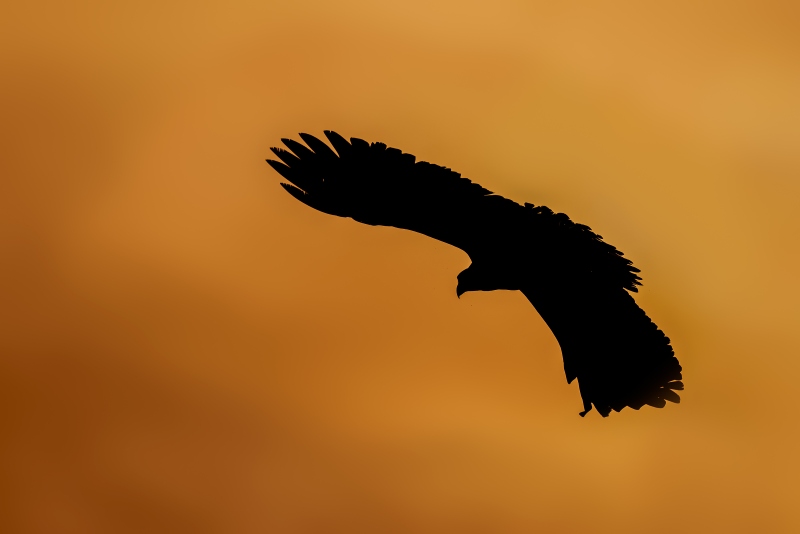
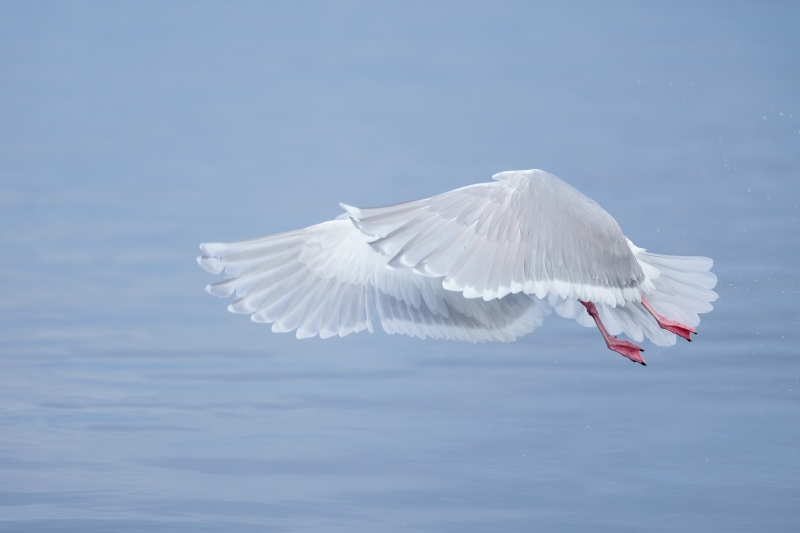
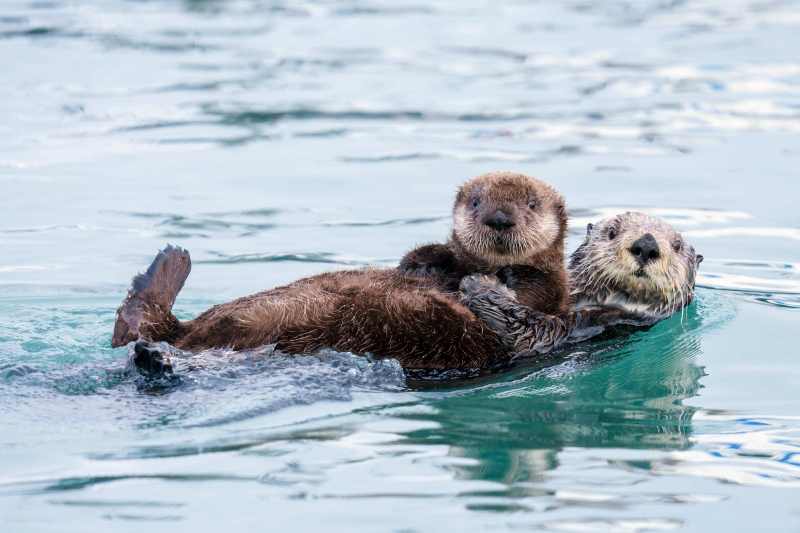
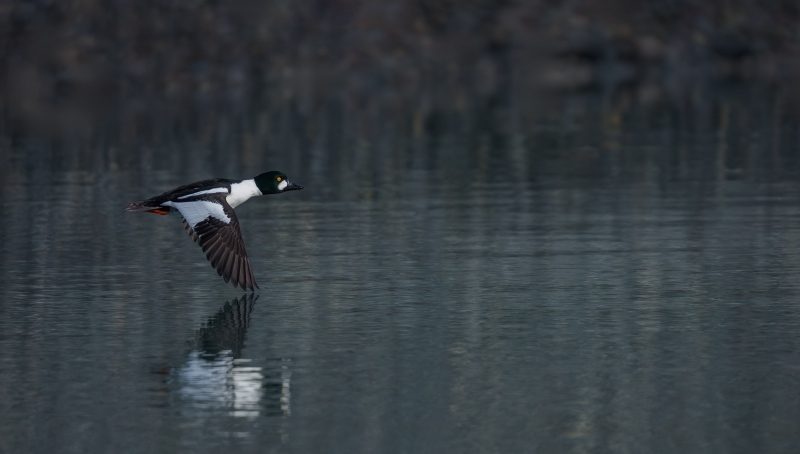









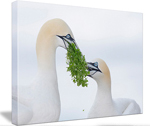



For me #3 is the best, a great environmental shot. I would follow that with #4 which has a very unique wing position which I have not seen before. And third for me would be #1.
Thank you Robert, and welcome to the blog.
artie
Images 5, 9 & 7. Nine is pure aaah factor and sentiment as I purchased a print of almost the exact same pose way back in 1976, when I was tripping around the US for the first time, and saw it in a gallery somewhere in California!
Thanks, Maggi. I have two very different and much stronger otter images that I will post here at some point.
a
All are fine images. Image #3 is my favorite. The overall scene places the eagle in a setting that has it all and feels at home. This one is balanced well and tells a story that holds the audience the longest, in my opinion.
Image 5 would be a close second but the snow or water under the wings appears to be more than above the wings and that left me with questions. Not bad, just a slight distraction. If the quantity of snow or water droplets were more equal, it might have taken first for me.
Thank you Mr. Redd!
artie
ps: What might have caused the water droplet pattern?
a
I don’t know for sure what caused the droplets but I would think that the bird just left contact with the bay after going for a fish.
Hi, Artie. #3 is my first pick and it’s miles ahead of the others for me. It’s a great landscape shot turned into a great background for a great flying bird shot. Second is #5. The water droplets must have come from a closer eagle that has flown out of the frame. The otters are #3 for me.